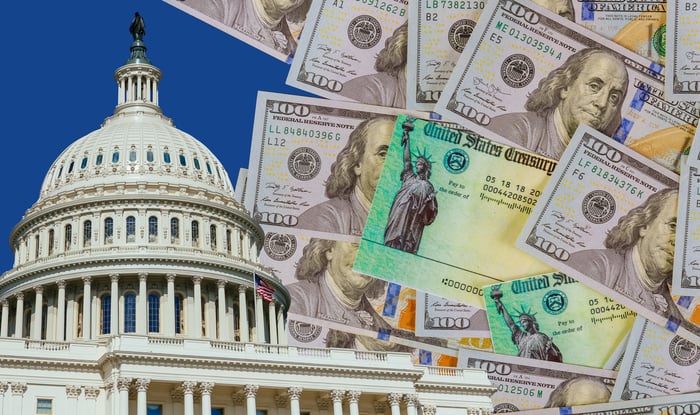For many Americans, 2020 is one of the most challenging years of their lives. The coronavirus disease 2019 (COVID-19) pandemic has led to a complete upheaval of societal norms, sent the U.S. unemployment rate to levels not seen in over eight decades, and cost roughly 165,000 Americans their lives.
While the fight against the coronavirus continues in laboratories around the world, U.S. lawmakers felt that the best way to tackle the financial maelstrom brought on by the pandemic was to throw a record amount of money at it. This is how the Coronavirus Aid, Relief, and Economic Security (CARES) Act came into being on March 27.

Image source: Getty Images.
A well-intentioned stimulus bill that missed the mark at the individual level
The $2.2 trillion CARES Act was a monster when it was signed into law. Its price tag is nearly triple that of what the Obama administration produced to save ailing banks during the financial crisis. The CARES Act ultimately provided $100 billion to hospitals to help fight COVID-19 infections, offered $500 billion to distressed industries, apportioned close to $350 billion for small business loans, and allotted $260 billion for an expansion of the unemployment benefits program for the four-month period ended July 31, 2020.
But most of all, the CARES Act put money directly into the pockets of American workers, families, and senior citizens. Some 160 million payments were disbursed by the Internal Revenue Service, with approximately $270 billion of the $300 billion directed toward direct stimulus paid out.
At maximum, individuals and couples filing jointly could qualify for an Economic Impact Payment of $1,200 and $2,400, respectively, so long as their adjusted gross income (AGI) fell below certain thresholds. Dependents under the age of 17 could also add $500 apiece to what a parent or guardian received.
It was a well-intentioned stimulus plan that did a lot for businesses, but failed to really provide much assistance at the individual level. That's because most stimulus recipients spent their money in four weeks or less. Considering how long the coronavirus pandemic could adversely affect the jobs market, these CARES Act payouts have proved insufficient.
A second round of stimulus is most definitely needed, and that's what lawmakers have been working on for the past couple of weeks.

Image source: Getty Images.
Five reasons stimulus deal 2.0 is being held up in Congress
Unfortunately, despite Democrats and Republicans both favoring a second round of direct stimulus to workers and senior citizens, a deal on a second stimulus package appears to be a long way off. Here are the five points of contention currently holding up stimulus 2.0 in Congress.
1. Enhanced unemployment benefits
Arguably the biggest difference between the Democrats' HEROES Act and the GOP-backed HEALS Act is how to handle enhanced unemployment benefits.
Under the CARES Act, approved unemployed beneficiaries received an extra $600 a week between April 1 and July 31, or until they found a new job. Democrats have been unwavering in their desire to see this critical enhancement continue at the $600 per week level, with the HEROES Act calling for this payout extension through January 2021.
Meanwhile, Republicans view this $600 a week stipend as too high and a disincentive for unemployed persons to get back to work. In the Senate-proposed HEALS Act, Republicans call for an enhancement of $200 per week, as opposed to $600 a week. By October, this flat payment would switch to a 70% wage replacement model.
Bridging this gap is going to be the toughest challenge for lawmakers on Capitol Hill.

Image source: Getty Images.
2. Benefits for undocumented workers
Another stimulus 2.0 battle brewing is whether or not undocumented workers and/or their households should qualify for a payment.
Under the HEROES Act, American citizens, as well as undocumented workers with an individual taxpayer identification number (ITIN), would qualify for a payout, as long as their AGI was below the set thresholds. Workers with an ITIN are paying federal taxes on their wages, despite the fact that they can't be assigned a Social Security number due to their citizenship status.
The Republican HEALS Act is very clear that undocumented workers won't qualify for a payment, even if they have an ITIN. Only individuals with Social Security numbers would be eligible for stimulus money.

Image source: Getty Images.
3. Funding for state and local governments
Lawmakers are also butting heads over what to do about state and local funding.
The HEROES Act, which cost a little north of $3 trillion, apportions approximately $500 billion in funding for state and local governments dealing with massive budget deficits tied to the pandemic. This funding would be split up over two years, with highly populated states like California, New York, Texas, and Florida accounting for $49.4 billion, $34.8 billion, $34.2 billion, and $24.2 billion in respective proposed payouts, according to estimates from the Center on Budget and Policy Priorities.
Republicans are staunchly opposed to the idea of using federal dollars as a budgetary stopgap for states -- especially when a significant amount of this funding would go to "blue" states. It's unclear if the GOP will budge on this stance.

Image source: Getty Images.
4. Liability shield protection
Keep in mind it's not just line items from the HEROES Act that are holding the next stimulus package up. A key component of the HEALS Act doesn't exactly have the support of the Democrat-led House of Representatives.
When introducing the HEALS Act a little over two weeks ago, Senate Majority Leader Mitch McConnell was adamant about including a liability shield for businesses and other entities, such as schools and hospitals.
The proposed liability shield would protect businesses from frivolous pandemic-related lawsuits through October 2024. Though lawsuits could still be filed, the plaintiff would need to prove gross negligence or willful misconduct to win. This should block most COVID-19 lawsuits from even heading to trial and protect businesses from a rapid rise in legal expenses.
Opponents of the liability shield argue that it would provide too much of an umbrella of protection for businesses and could make it even harder to control the pandemic.
Though Democrats are mostly focused on boosting benefits for the unemployed, don't overlook disagreements with the GOP over the liability shield.

President Trump speaking with reporters. Image source: Official White House Photo by Andrea Hanks.
5. Trump's payroll tax push
Lastly, President Trump is partly responsible for gumming up the works.
You see, Trump's stimulus plan is completely different from what was proposed under the Republican HEALS Act. Last weekend, Trump signed a series of executive orders that would reinstate enhanced unemployment benefits at $400 extra per week, as well as defer payroll taxes for tens of millions of working Americans for the final four months of the year.
The problem is that any disruption to the collection of the payroll tax, which is Social Security's primary source of revenue, could do irreparable harm to the program. Even if this is just a deferral of the payroll tax (i.e., it would need to be paid back in 2021), it could still make Social Security worse for the wear.
Neither Democrats nor Trump's own party supports the idea of a payroll-tax deferral, which is creating even more tension on Capitol Hill.
The point is, it could still be many weeks before we see any real progress on the next stimulus package.






